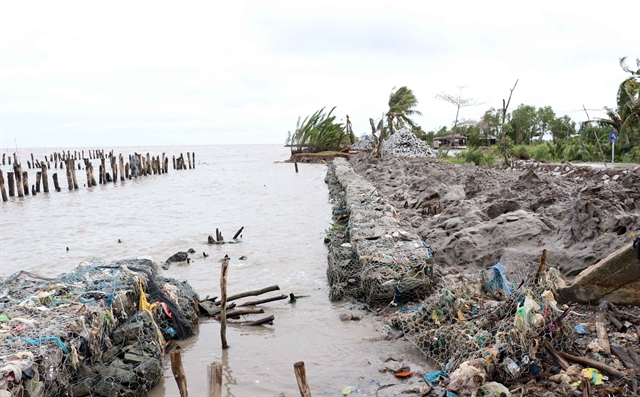 Environment
Environment

Many sections of the western sea dyke in Cà Mau and Kiên Giang provinces in the Cửu Long (Mekong) Delta have seriously eroded and could collapse at any time if prompt protective measures are not taken.

|
| An eroded section of Cà Mau Province’s western sea dyke. — VNA/VNS Photo Huỳnh Anh |
HCM CITY — Many sections of the western sea dyke in Cà Mau and Kiên Giang provinces in the Cửu Long (Mekong) Delta have seriously eroded and could collapse at any time if prompt protective measures are not taken.
Strong winds, rough seas and big waves occurring with considerable frequency in the two provinces’ western coasts have resulted in severe erosion of the western sea dyke.
A 700m section of the western sea dyke in An Minh District’s Vân Khánh Tây Commune in Kiên Giang has been damaged by the impact of tropical typhoon Sinlaku back in 2008. The storm caused salt water to intrude deep into the arable land, severely affecting local agricultural production.
The provincial People’s Committee said that forces had been mobilised to reinforce the damaged dyke section. However, many locals are worried about continued erosion on rainy days.
In the long term, the province will build outside embankments and breakwaters, as well as restore protective forests to protect the dyke.
It is also urging people to move to safe areas to mitigate possible losses and damage.
Localities have been asked to develop plans to mobilise all resources on site and be ready to respond when a bad situation happens.
Erosion has occurred in three sections of the western sea dyke in Cà Mau with a total length of nearly 3,000 metres.
If the dyke breaks, about 26,160 households living in the coastal area and 90,000ha of agricultural land could be affected.
Tô Quốc Nam, deputy director of the province’s Department of Agriculture and Rural Development, said the western sea dyke could collapse if there are no appropriate solutions.
The department is undertaking urgent works to protect the dyke, but these have been delayed due to unfavourable weather conditions, he said.
Chairman of the province’s People’s Committee Nguyễn Tiến Hải has urged contractors to speed up construction of embankment projects and deal with landslide sites.
The Department of Agriculture and Rural Development has been asked to work with relevant units to review the entire western sea dyke and propose appropriate solutions to the committee.
Anti-landslide projects
The Tây Nguyên (Central Highlands) province of Đắk Nông has approved construction of two anti-landslide projects along the Krông Nô River, with a total cost of nearly VNĐ62 billion (US$2.68 million).
According to the provincial People’s Committee, the two projects will limit landslides, protect production areas and households on both sides of the river, and ensure traffic safety on National Highway No 28.
One of the projects is a 305m embankment along the river in Krông Nô District’s Nâm N’Dir Commune. It is worth VNĐ40 billion ($1.73 million).
Another VNĐ22 billion ($950,000) project is to build an embankment along the river in Krông Nô District’s Đắk Nang Commune.
According to the province’s Department of Natural Resources and Environment, the landslide situation along the banks of Krông Nô River has become more serious over the years, mostly in Đức Xuyên, Nâm N’Đir and Buôn Choáh communes in Krông Nô District.
The department has recorded 17 landslide sites along the river with a total length of about 10km.
Experts said the landslides could also be caused by the impact of sand mining activities, especially sand exploitation close to the river banks or those exceeding the permissible limit.
Unusual weather patterns due to the impact of climate change are also among the major causes of the landslide.
Besides building dykes to prevent landslides, more effective solutions are needed to limit riverbank erosion, experts said. — VNS




